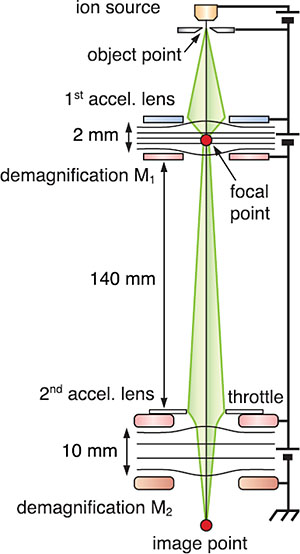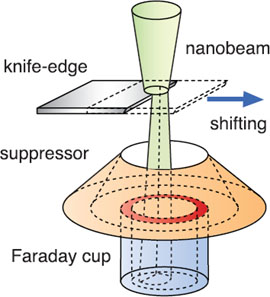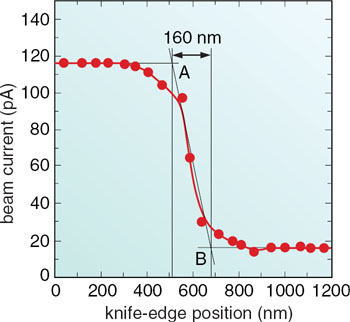Ion nanobeams with energies in the tens of keV range are utilized for fine material surface processing and precise elemental distribution analyses. Nanobeams of liquid-metal ions, such as Ga and Si, are commonly produced by focused ion beam systems (FIB). Irradiation with the metallic ions, however, has the serious disadvantages of damaging the material surface by sputtering, and causing implantation of the metal ions as impurities.
Gaseous ion (H+, He+) nanobeams are required to overcome these disadvantages. The gaseous ions are generally produced by a plasma ion source, supplying a beam spot of down to 100 micrometer in diameter at extraction. A focusing lens system with demagnification over 1000 is required to form gaseous ion beams with a 100 nm diameter spot. Such high demagnification is, however, unachievable with conventional magnetic or electrostatic lenses. A pair of acceleration electrodes with a small single center hole (accel. lenses as shown in Fig. 6-8) was designed as a focusing lens with high demagnification. The accelerating lens has the dual functions of beam focusing and acceleration. A total demagnification over 2000 has been achieved with a focusing lens system which consists of a series of accelerating lenses. The lens system requires incident ion beams with low energy, a small energy spread and a small divergence angle in order to achieve high demagnification. A duoplasmatron-type ion source has been developed to meet these ion beam conditions. In addition, a nanobeam spot size measurement system with a resolution better than 20 nm has been developed to accurately evaluate beam spot size in the nanometer range. The beam current, reduced by a sharp knife-edge transversing the nanobeam, was measured as a function of the knife-edge position, as shown in Fig. 6-9. Beam sizes were estimated from the beam current change.
The gaseous ion nanobeam formation system has been developed by combining the acceleration lens system, the ion source and the nanobeam spot size measurement system. A 160 nm diameter beam spot for a 46 keV H2+ beam, the smallest one in the world, has been formed using this system (Fig. 6-10). The gaseous ion nanobeam will open up new nanotechnologies for material surface processing and analysis without injecting residual metal species and causing incidental damage. |


